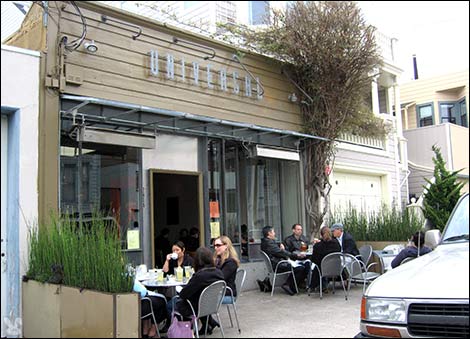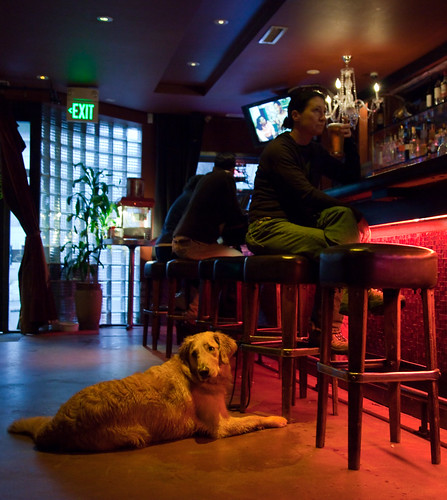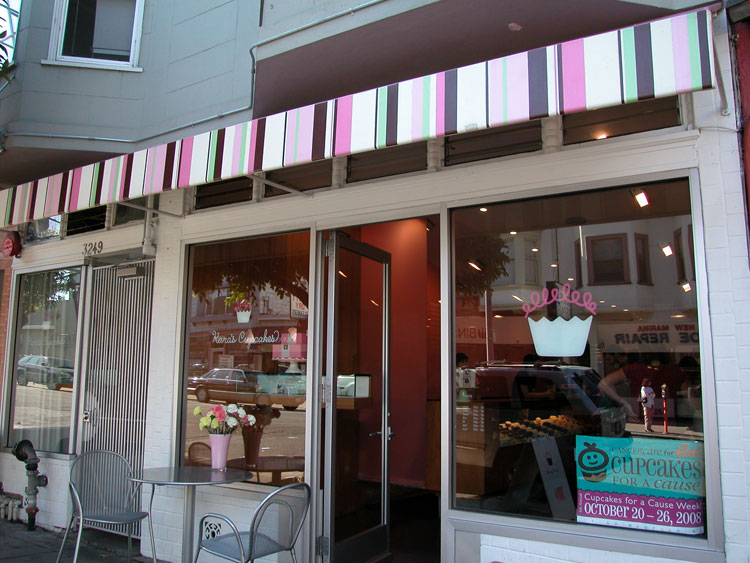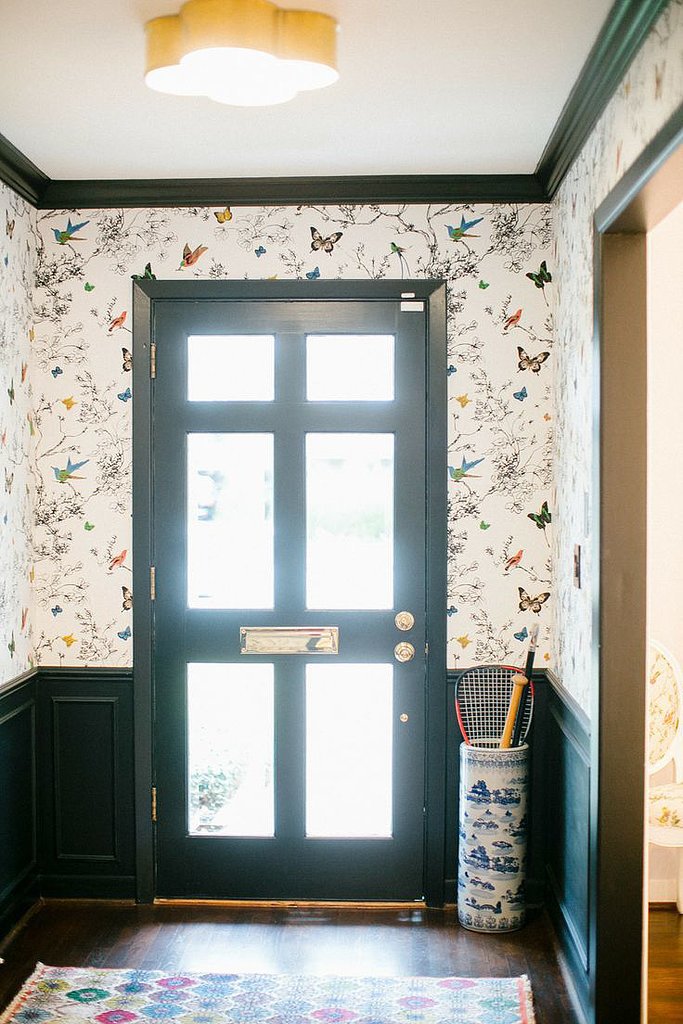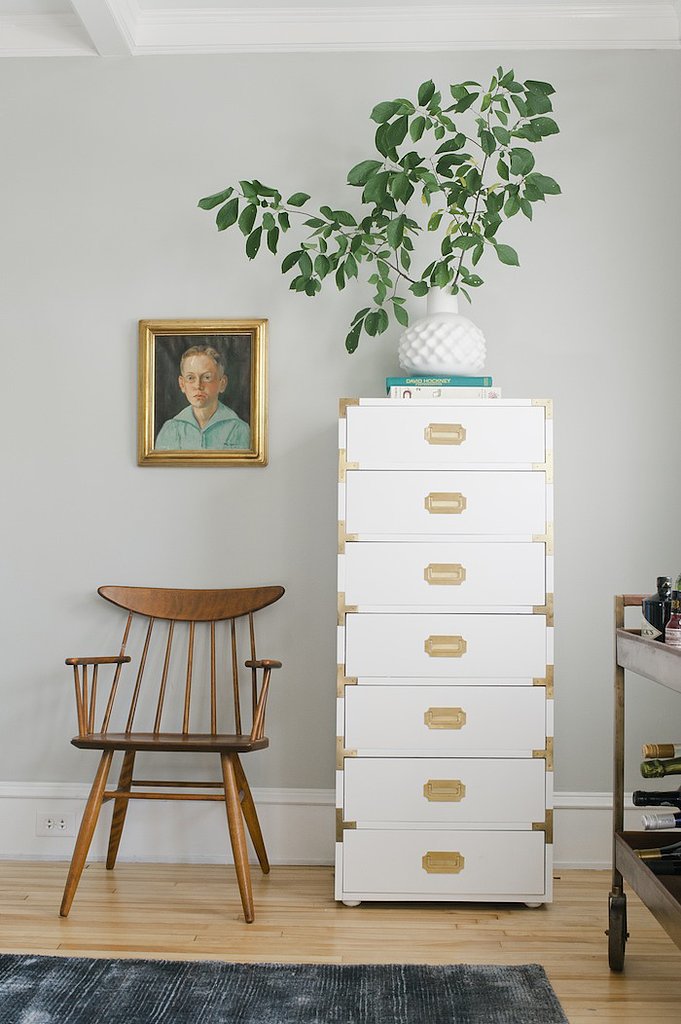's fifth anniversary, though it doesn't outwardly appear to have aged a day. Founded by
, with a killer selection of Burgundy.
in the national Grand Cochon competition. The duo sat down to discuss
the restaurant's past and future, why they want Bauer and Michelin to
give them another look, and coordinating with the restaurant's twin up
in Seattle.
Michael, let's start with you. When you first envisioned the RN74 concept, what did you want the restaurant to be?
Michael Mina: When [sommelier and RN74 co-owner]
Rajat Parr
and I had Michael Mina at the St. Francis, he had a really dynamic wine
list over there. So when we'd get down to one bottle on that list, it
would be really hard, because with a big list like that, you can't just
86 different bottles every night. The little space across the way, which
is now
Clock Bar, became the center for an idea Raj
had for a wine bar called The Last Bottle. And he came up with the idea
of the train board, when we got down to the last bottle, we'd take it
off the list in the morning and put it up on this board and sell it. And
I agreed that it was a really great idea—for a restaurant.
Raj is really passionate about Burgundy, and we started talking about
creating a restaurant that focused on Burgundy wines, with a modern
French bistro feel. The food style I've always done is very bold—I like
bold acidity, sweetness, spice, richness—and that's not always the most
wine-friendly style of food. Raj was very good at working with my style
of food, but for this restaurant, we wanted to think about wine first,
and think about how the food and wine experience worked together.
So how did you go about choosing this space?
MM: Whenever I travel, I check out new spaces and
restaurants. At that time—2009, when the economy was really down—we
wanted to create a restaurant with a very warm and social feel. There's a
restaurant,
Public, in New York, that was designed by
AvroKo, and I always loved the feel of it. Whenever I went, I'd go, "You
could drop this in San Francisco tomorrow," because it just had that
level of chic in the design, but it was very social in feel. So we
agreed on AvroKo, and the train board morphed into a whole feeling for
the space, with the market list of wines on the opposite wall.
From day one, we wanted this space to have two menus—one for the wine
bar, the other for the restaurant. We put the movable wall into the
atrium space, so we could create different experiences depending on
volume—make it more intimate, or expand it by moving it back. The idea
was to have a very high level of wine and a very high level of food, but
in a more casual environment.
Even in a casual environment, Burgundy isn't the most
affordable luxury. Given that it was the height of the recession, was it
stressful or scary to bring this place online?
MM: It was. Although one thing that helped was the
[Enomatic machine], and being able to have 18 wines by the glass. People
wouldn't order a whole bottle, but they would have a glass. And we kept
food prices low. For what you're getting, the food prices—both back
then, and to this day—are pretty reasonable. We're still using very
high-level product, and there's a high level of detail that goes into
the food, but I'd say the price point is 20-30% lower than many
similarly-styled restaurants.
Now that the city's in a boom, have you felt the urge to make it more high-end?
MM: Well, that's where Adam comes in. Whenever you
have a new chef, the food's direction changes, but I genuinely feel that
at this moment, the food at this restaurant is some of the very best in
the city. We didn't have to really change the price point much to do
it—Adam's been able to just raise that level on his own. All the
elements are coalescing to help him do that: having more folks in the
kitchen, having a staff that's been together for a longer period of
time.
Adam, you weren't living in SF when you were offered this job, correct?
Adam Sobel: I wasn't. I was in D.C., working at
Bourbon Steak
at the Four Seasons, and chef made me an offer I couldn't refuse. I
started here a year ago: April 1, 2013. Before that, I was a huge fan of
this restaurant, and the philosophy of it fit my style and how I like
to cook; I liked the social dining experience, the fun atmosphere, and
Burgundy, which is what I love to drink most. It was a no-brainer.
It was already a great restaurant, so my job was just to evolve the
cuisine. I knew what chef wanted in terms of his vision for the
restaurant. We both want it to be a place where people can come to eat
three or four times a week; that's really the whole idea. Approachable,
but with some refinement and some classic French elements to it.
The chef before Adam was [former French Laundry sous] Jason
Berthold. Having experienced both Adam's and Jason's cuisine, Michael,
how would you say that they differ?
MM: Adam uses slightly bolder flavors, and his
thought process behind the dishes is more involved in utilizing things
people are familiar with and adding a "wow" factor and twists to them.
Both of them have a lot of technique in their food, and Jason had taught
the cooks a level of technique that Adam was able to harness when he
came in, which was really positive.
Was that something that you consciously knew you were
bringing in, or did it reveal itself when you were working on the new
menu?
AS: Well, I should say that I'm a big fan of
Jason's. When I came to visit SF, this was always the first restaurant
I'd come to. His style and mine are different, but I came into an
operation that was technically sound and had great systems in place, and
I was blessed in that way. But yes, I knew that I could make a big
impact, because my style is so different. So far, it's been good. I
think every week, we get better.
MM: The menu right now is the best one you've done.
If someone was coming in to eat here for the first time, what menu items would you recommend?
AS: The croque-madame gougeres. That's an item I was
thinking about before I came out here—a French staple, but with a fun,
shareable element. We stuff the gougeres with mornay, then top them with
crispy prosciutto and a fried quail egg. It's a one-biter: you drink
champagne, pop a few of those, and get your night started. The duck
wings a l'orange were another way to make a classic food
shareable—cooked confit, fried crispy, then glazed. I like our kampachi
and avocado crudo on squid-ink flatbread, and the tuna nicoise with
poached albacore belly. The guidelines are that I like to keep it
French, but I like to draw influence from French colonies, so we do a
beef tartare with Vietnamese flavors, which I think is more exciting for
people.
What dishes are the most popular with diners?
Well, everything changes with the seasons: tomatoes are popular in
summer, asparagus in spring, braises in winter. But the roast chicken
has been on there since the beginning—it's the first time I've ever had a
dish on a menu this long. It's a play off of coq au vin.
Any items that didn't fly?
MM: One that Jason did—I was so bummed that it
didn't take off, because I thought it was great. He did the classic
radishes dipped in butter with salt, and they were so good. We couldn't
sell them. He was keeping them on the menu for me. I had to take them
off.
AS: It's so weird sometimes. Things that you think
won't sell, you'll be like, "Eh, we'll give it a shot," and they do
well. I did calf's liver as a special, and we sold it out every night.
But when we put it in print, then it didn't sell. It's very weird.
Verbal specials will sell, and then once they get printed, they're dead
ducks on the menu.
 This restaurant is unique in that it has a sister restaurant,
with the same concept, in Seattle. What level of interaction is there
between the way you run it here and the way you run it in Seattle? Do
you guys talk?
AS:
This restaurant is unique in that it has a sister restaurant,
with the same concept, in Seattle. What level of interaction is there
between the way you run it here and the way you run it in Seattle? Do
you guys talk?
AS: Well, it worked out well for us because [former Mina Group corporate chef]
Dave Varley is the new chef there,
and he's one of my best friends. Both Michael and I speak to him
regularly, and we've got an incredible connection and continuity between
the restaurants. Our styles are similar, and we all have the same
mentality and palate, so it's really great.
If I were to go into RN74 in Seattle, would I see a menu very
similar to yours, or one with the same vibe that's still more
expressive of Dave's style?
AS: There are dishes that are similar: the bone
marrow is pretty much identical, the snails. Dave has been with Michael
for five years, I've been here almost four. So there's a lot of
similarities. [Michael nods.] If you ate there, you might think Dave was
cooking, you might think I was, you might think Michael was.
So you generally all share the same sensibility?
MM: Yeah, we do. The difference up there is that the
products are different, and both Dave and Adam use a lot of local
products. For example, asparagus, morels, and peas come in very late in
the summer up there. Their seafood is different. So there's things
you'll see on the menu there that we just don't get.
More than most restaurateurs, you deal with opening similar
concepts in different regions. In opening RN74 again in a different
city, how did you have to adjust it? What are the regional variations
between the two restaurants?
MM: The wine. There's a lot less Burgundy [on the
list] in Seattle, and a lot more Washington State and Oregon wines. The
French wines don't sell up there. Here, they sell like crazy.
Is that a price-point issue?
MM: Could be. But people spend money up there. I
think they just like their local wines. They like to support Oregon and
Washington winemakers.
But it's not like California doesn't have local wine.
MM: I know! At this particular restaurant, people just order
a lot of French wine. They love French wine.
Has that defined your identity over time? Are you being seen
first and foremost as a destination for people who love French wine?
MM: It's funny—we did a study, because we wanted to
know how we were perceived, and we polled hundreds of people. "When you
think of RN74, what comes to your mind first?" And the answers were all
over the board. Ten percent, the first thing that came to mind was happy
hour. That wasn't even in our original plan, it wasn't even budgeted.
It gives the restaurant a great energy going into the night, but I'd
never had a restaurant that was busy between lunch and dinner.
But the survey, it was really mixed. A lot of people just see it as a
restaurant, and then another good chunk know it primarily for Burgundy.
How do you balance all those constituencies?
MM: In San Francisco, I think it works to your
advantage. Taking it on the road would be really difficult, because it's
not something that works everywhere. But here, there are so many people
that are into food and wine here that the ones who are into food will
seek out places for food, the ones who like wine will seek out places
for wine, the ones who are into design...
Design junkies come here?
MM: The one thing I felt strongly when we opened
this place was that its look was timeless. It's five years old, and
there's nothing dated about it.
Have you made any real changes to the look of it?
MM: None. At all.
AS: It's got a sexy feel, and it's warm.
MM: It feels handcrafted, like one of those rooms
you don't want to change even after a while. And, knock on wood, we'll
be here for a while.
So if you could go back in time, there's nothing you'd change?
MM: Well, the bar area—I think I need to change some
of the seating in it, and make it a little bit more conducive to
conversation. Functionally, the bar area is just much busier than we
ever expected it to be. In hindsight, I probably would have extended the
bar all the way down, and made it a three-sided bar to give that space
to the bartenders. And that back wall is supposed to be all greenery.
They told me it was going to grow, and it hasn't. It's now five years,
so I don't think it's going to happen! [Laughs.] I want it to be more
lush, so I've got to get that change.
AS: It's a pretty efficient and powerful kitchen,
for the space we have. I'd maybe add another combi oven, but it's pretty
amazing, the volume we're able to pump out of it. We can have 40 in the
atrium, 100 in the dining room, 30 in the owner's lounge upstairs, and
we can do it all. Maybe I'd bust out the back wall and extend the prep
area.
Has the clientele changed over time?
MM: It has, and I think part of that is due to happy
hour, and how much happy hour took off. Lunch and dinner is still the
same clientele, but a lot of the happy hour people who might not have
typically dropped in are staying for food, or coming back to try the
restaurant.
Do you feel the need to change things, to draw that crowd?
MM: We feel the need to change things all the time. I
think that's the most dynamic part of being a chef. I'm a firm believer
that every day, your restaurant is better or worse than it was before;
it's never the same. Every day, you've got 80 human beings who you're
dealing with. The more you change things, stimulate people, give them a
reason to refocus, the better chance you have to keep them engaged.
Michael, you're popping up all over the country. Do you see this concept going elsewhere?
MM: Probably not. At least, no plans right now.
Where do you want the restaurant to go in the future? What do you want to be seen as, or known for?
AS: Deliciousness. That when you look at the menu,
you want to eat everything. That's the goal every time I do a menu, to
make it really difficult on the guest to decide what to eat, so they
come back again to try things they missed. I want this to be regarded as
one of the top restaurants in the city. And I'd like to get
re-reviewed. [
Editor's note: Bauer's last visit was in 2011, two years before Sobel came on board, and the review wasn't positive. He later dropped it from the Top 100.]
MM: This is one of those restaurants that's really
benefitted from five years, from growing up. Being re-reviewed, being
recognized, I don't think it's ever happened for this restaurant. This
restaurant is the best it's ever been. The wine list, the wine service,
the food, it's all very special. We've got three sommeliers on the
floor, which is rare for a restaurant of this size, and there's a reason
for that. Over the last six months, we're getting the best feedback
we've ever gotten and we're the busiest we've ever been.
Besides Adam's presence, what made the difference?
MM: We have an amazing new GM; he and Adam went to
school together. And a lot of times, that connection of a great GM and a
great chef that have a rhythm together is what does it. Sometimes
you'll have an amazing chef, but not have the same level in the front of
house, or vice versa. It's like mom and dad. When they're on the same
page, the house is on the same page, and when one of them isn't, there's
missing pieces.
AS: Lucas knows me probably better than anybody: my
brother, my mom and dad, and then him. We have an understanding, we
support each other. Sometimes we butt heads, sometimes our comfort level
creates a little bit of friction, but we work for each other. He works
really hard to keep the staff energized and inspired. I've worked with
GMs where I felt like it was an uphill battle every day, and it's always
an argument. That's not the case here. Every day at 3, we go over the
day before, today, tomorrow, and our plan of attack for improvement.
Pretty simple, but a lot of restaurants don't do that.
MM: I feel that this restaurant deserves to be
really looked at by Michelin in contention for a star. When I look at
the level of the wine, the food, everything else, I feel like it should
have that. Adam has a national reputation as a chef. He won Cochon. It
takes 4-6 months for a chef to get his feet wet. Anybody who has not
experienced this restaurant in the last 4-6 months has not experienced
what RN74 is. To have a chef in this city, at this level...a lot of
people think "Yeah, I've already been there." But you haven't been to
RN74 if you haven't tried Adam's menu. It is a completely different
restaurant.
Article & Photos Taken from: http://sf.eater.com/archives/2014/04/24/michael_mina_and_adam_sobel_of_rn74.php






